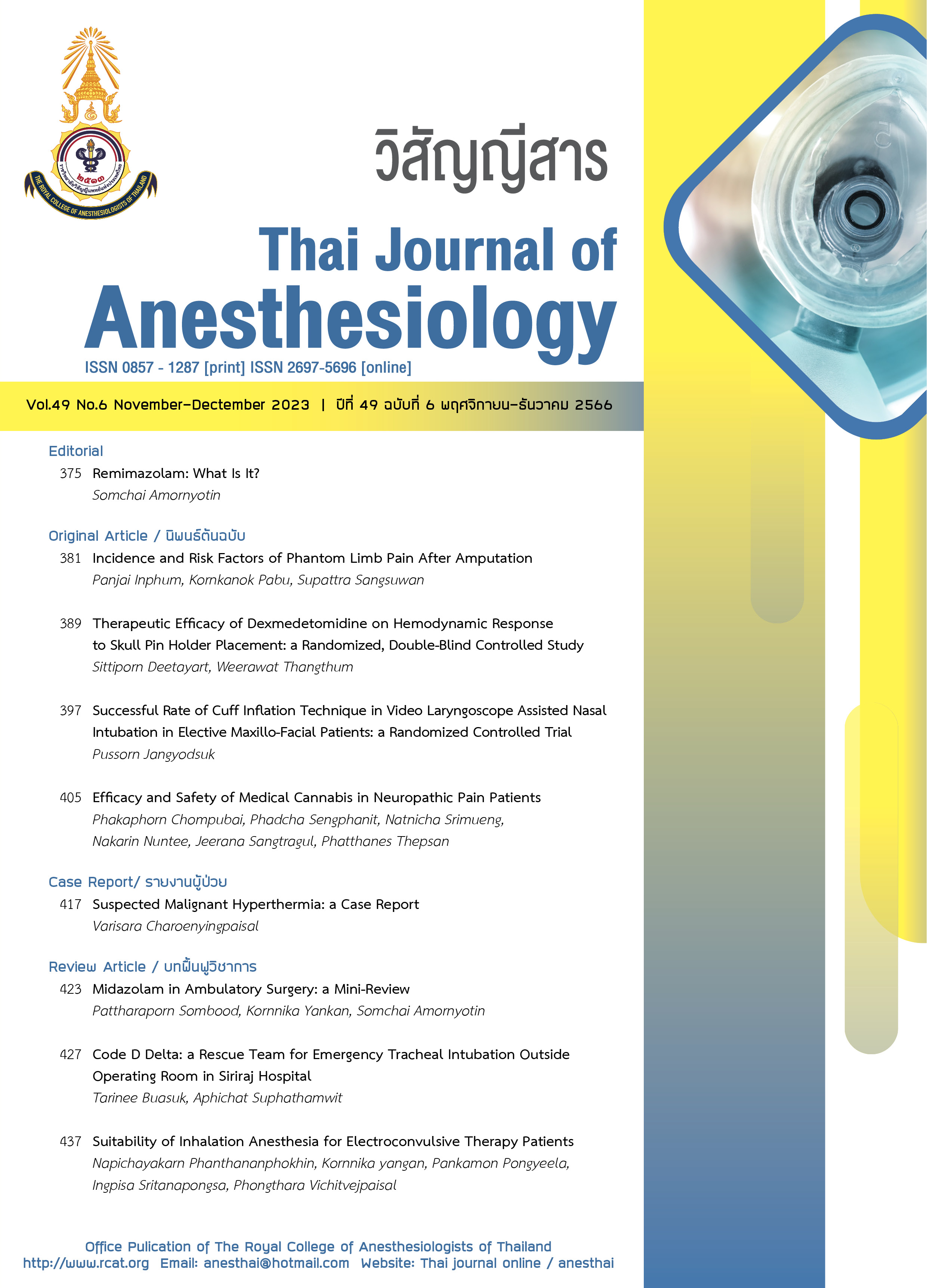Therapeutic Efficacy of Dexmedetomidine on Hemodynamic Response to Skull Pin Holder Placement: a Randomized, Double-Blind Controlled Study
Main Article Content
Abstract
Background: The skull pin holder placement in neurosurgery is the strong stimuli that produced the intense sympathetic response. Dexmedetomidine is one of many drugs that have been used to attenuate this response. We evaluate the effective intravenous dose of dexmedetomidine 0.5 µg/kg and 0.75 µg/kg infusion that can blunt hemodynamic response. Methods: This study is a prospective, randomized controlled double-blinded study. A total of one hundred and twenty patients were selected and randomized into three groups of forty patients each: group 1 received an infusion of dexmedetomidine 0.5 µg/kg, group 2 received an infusion of dexmedetomidine 0.75 µg/kg, and group 3 received an equivalent quantity of normal saline. Hemodynamic parameters were monitored regularly of skull pin holder placement. Result: There was no significant difference in the monitored hemodynamic parameters among the three groups from baseline until intubation time. Heart rate (HR) and mean arterial pressure (MAP) increased significantly in group 3, whereas the values decreased in group 1 and 2 (P<0.001). Group 2 showed a higher and sustained attenuation of HR and MAP. Group 3 had a higher incidence of tachycardia and hypertension that need medication to treat the response. Conclusion: Dexmedetomidine in both doses (0.5 µg/kg and 0.75 µg/kg infusion) was effective in attenuating hemodynamic response to skull pin holder placement.
Article Details

This work is licensed under a Creative Commons Attribution-NonCommercial-NoDerivatives 4.0 International License.
References
Paul A, Krishna HM. Comparison between intravenous dexmedetomidine and local lignocaine infiltration to attenuate the haemodynamic response to skull pin head holder application during craniotomy. Indian J Anaesth. 2015;59:785-8.
Lin N, Vutskits L, Bebawy JF, Gelb AW. Perspectives on dexmedetomidine use for neurosurgical patients. J Neurosurg Anesthesiol. 2019;31:366-77.
Nguyen A, Mandavalli A, Diaz MJ, et al. Neurosurgical anesthesia: optimizing outcomes with agent selection. Biomedicines. 2023;11:372.
Demartini Jr Z, Gatto LAM, da Rocha TC, et al. Is the Mayfield head holder obligatory for intracranial aneurysm clipping? Pediatr Neurosurg. 2018;53:360-3.
Singh G, Arimanikam G, Lionel KR, et al. Comparison of dexmedetomidine infusion versus scalp block with 0.5% ropivacaine to attenuate hemodynamic response to skull pin insertion in craniotomy: a prospective, randomized controlled trial. J Neuroanaesth Crit Care. 2021;8:180-6.
Smith FJ, van de Merwe CJ, Becker PJ. Attenuation of the haemodynamic response to placement of the Mayfield skull pin head holder: alfentanil versus scalp block. Southern Afr J Anaesth Analg. 2014;8:4-11.
Masoudifar M, Amini-Tehrani MH, Kashefi P. Comparison of the hemodynamic indices during skull-pin head-holder insertion in neurosurgeries in two groups receiving dexmedetomidine and midazolam. J Isfahan Med School. 2020;38:790-7.
Bala R, Arora V, Anshul A, Arora R, Kamal K, Malhan S. A comparative study of intravenous Dexmedetomidine with local infiltration of ropivacaine in attenuation of stress response to skull pin insertion in craniotomies. Asian J Neurosurg. 2022;17:463-9.
Nasr YM, Waly SH, Morsy AA. Scalp block for awake craniotomy: lidocaine-bupivacaine versus lidocaine-bupivacaine with adjuvants. Egypt J Anaesth. 2020;36:7-15.
Blue R, Alexis M, Mensah-Brown K, et al. Endoscopic microvascular decompression without the use of rigid head fixation. J Clin Neurosci. 2022;106:213-6.
Ahmed MNU, Afifa M, Salim M, Asaduzzaman M, Rahman AF. Dexmedetomidine for sedation and analgesia in mechanically ventilated patients. Sch J App Med Sci. 2021;9:149-55.
Venkatesh S, Karthik RM. Prospective randomized study to compare between intravenous dexmedetomidine and esmolol for attenuation of hemodynamic response to endotracheal intubation. Anesth Essays Res. 2016;10:343-8.
Bruder NJ, Ravussin P, Schoettk P. Cottrell’s and Young’s Neuroanesthesia, Sixth edition, USA, Elsevier, 2017;p190-208.
Castillo RL, Ibacache M, Cortínez I, et al. Dexmedetomidine improves cardiovascular and ventilatory outcomes in critically ill patients: basic and clinical approaches. Front Pharmacol. 2020;10:1641.
Senapati LK, Samanta P. Effect of dexmedetomidine on dose requirement of propofol and thiopentone induction in patients under general endotracheal anesthesia. Asian J Pharm Clin Res. 2018;11:262-5.
Wu J, Li B, Ma K, Li H, Shao X. A systematic review and meta-analysis of the clinical efficacy of the intravenous injection of dexmedetomidine in ICU patients with hyperactive brain syndrome. Ann Palliat Med. 2022;11:299-308.
Kondavagilu SR, Pujari VS, Chadalawada MV, Benvinguddaiah Y. Low dose dexmedetomidine attenuates hemodynamic response to skull pin holder application. Anesth Essays Res. 2017;11:57-61.


